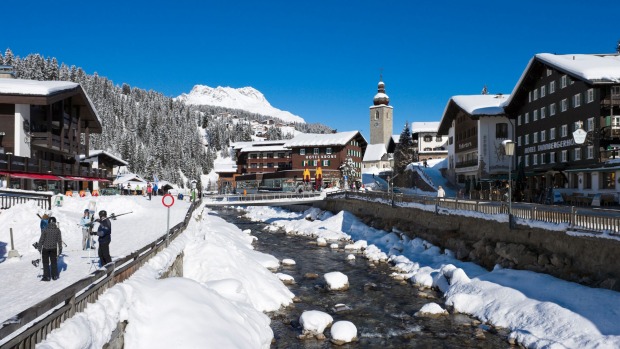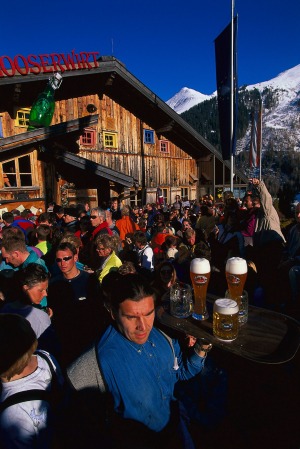
It's just turned 3:30 on a mid-week afternoon in St Anton and the ski slopes are completely empty. Despite boot-deep powder snow and clear blue skies it's the time of the day every skier's attention in the Arlberg region shifts entirely to apres ski over downhill skiing. I ride down to world-famous apres ski bar, Heustadl, on the ski slopes above St Anton's historic village. Hundreds of skis and snowboards have been thrown haphazardly against far too few ski racks; the excess sprawl out onto the slopes. How anyone remembers whose skis belong to whom is a modern-day Austrian mystery. Outside Heustadl, a group of male skiers dressed as buxom Viking women drink glasses of cold beer beside skiers dressed as various super heroes, and as gigantic, fluffy bunnies, and cats … even roosters. I push the heavy bar door open and step inside. Skiers and boarders are packed in like sweaty sardines, the Village Peoples' YMCA is playing at high volume and get this: the entire bar is dancing along. Women in ski boots dance on bars, men – just like Australians, with little natural rhythm – sway their hips and wave their arms; no-one's too cool to join in… "it's fun to stay at the Y-M-C-A," every single patron of the bar forms the Y, the M, the C and the A together, and for the 100th time in a decade of both living here and visiting on ski vacations, I think: this could only happen in Austria.
"This is our love affair… skiing," young Austrian snowboarder Georg Hatig says outside the bar. "We take everything about skiing as a matter of national pride, even apres skiing… actually, especially apres skiing." Austria is a country governed entirely by traditional rules and strict protocol. Living here and fitting in, as I discovered, can be complicated. But Austria's ski regions are the exception, especially here in the Arlberg region.
"Austrians unwind when we ski, we don't have to follow the old rules," local Franzi Koell says. "Maybe that is why we go that little bit crazy here. Every ski resort on Earth tries to copy our apres ski, but there is only one Arlberg." Indeed, the very concept of apres ski was said to have started here in St Anton.

Meanwhile, just across the valley within the more cultured confines of up-market ski village, Lech, the favoured ski destination of the late Princess Diana, 1964 Austrian Olympic downhill ski gold medallist Egon Zimmermann rubs his tired eyes and lets out a sigh. "Yes, it is exhausting, of course," he says. Zimmermann's run a guesthouse in Lech for 40 years; he treats every guest like family, every single guest. "We try hard to make every guest feel at home, this is what we do in Austria."
Even back home at Victoria's Mt Buller ski resort, Australia's most famous Austrian guesthouse host, Hans Grimus, nods his head and agrees. "Austrians create monsters for themselves," he says. "Every person that's come to my pension and restaurant wants to share a schnapps with me, so what do I do? I share a schnapps with them. In Austria, that is what we do."
Austria's Arlberg ski culture has been exported across the ski world, serving as the blueprint for many of the world's ski resorts. Modern skiing was invented here on these slopes 100 years ago by Arlberg skier Hannes Scheider, then disseminated to every corner of the globe. Even our own ski resorts, especially Thredbo and Mt Buller, are like living, breathing Arlberg ski museums.
It's a region defined by much more than its majestic mountains – although these are some of Europe's most dramatic - rather it's the Arlberg's reliance on family-owned businesses, and its unrivalled sense of fun that elucidates it.
"I know of a group of American ski managers who were taken to the Arlberg recently and they said they realised they still had so much to learn about how to create atmosphere from us," Grimus says. "Americans know grooming, Austrians know atmosphere."
On a recent trip to a ski resort in Colorado, a bar owner told me: "We've tried so long to create that Arlberg magic but the Austrians just seem to get it where no-one else does."
There are no hotel chains in the Arlberg and its ski villages are old farming towns with thousand-year histories. You'll find barbers, shopkeepers, bakers and milkmen going about their business in tiny, traditional villages, as they always have, and always will. In most parts of the Arlberg, skiers must take free buses between ski villages – cars aren't allowed (car parks are hidden away underground), and there's a limit to day visitors for the comfort of overnight guests. Nor are there unsightly electricity cables or telegraph lines, and strict standards are set on building heights – few buildings stand higher than three storeys, and houses in general cannot occupy more than half a block of land. Those who own guesthouses in most areas of the Arlberg must also live here and run them, ensuring a level of personal service you won't experience anywhere else.
"When some of the ski resort people from France came here they said 'oh, we made a big mistake, we brought in big hotel chains, big apartments, big highways and big parking lots," Lech guesthouse owner Hubert Schwarzler says. "Their big mistake, they admit, was they bought the locals out. There's no barbers, no bakers, it's all about big business. Customers come and they're treated like numbers. That will never happen in the Arlberg."
"Visiting the Arlberg is like coming to the world's most beautiful and challenging ski terrain that's actually right outside your grandma's house," local skier Georg Hartig says. Many pensions are guilty of a quaint kitschness you won't find elsewhere, complete with doilies, Christmas music and Michael Buble on high rotation. But it all creates a level of comfort you won't find in chain hotels. "Guests should feel like they're at home with family, that is the Austrian way," Zimmermann says. "Take your boots off, put on your slippers, this is your house, you are not in a hotel."
The Arlberg region, which sits in Austria's south-western corner bordered by Switzerland, actually comprises five uniquely different ski villages and offers 84 cable cars and lifts providing access to a whopping 280 kilometres of groomed ski runs and 180 kilometres of open free-riding terrain… all on the one ski ticket.
Every ski taste is catered for in the Arlberg; from the youthful exuberance of St Anton's world-famous nightlife to the high-end comforts of Austria's most prestigious ski destination, Lech; the exclusive St Christoph, the ski-in, ski-out convenience of Zurs and cosy Stuben, home to just 100 year-round locals.
Only the ski villages of Switzerland can possibly match the Arlberg's spectacular alpine scenery. Here, baroque churches and timbered chalet-style houses of hanging eaves and carved balconies draped with snow look out across soaring valleys. Avalanche barriers are the only obstacles stopping villages below sheer mountain passes being swept away by winter's regular snow storms. Even mountain goats cling on for dear life in a terrain that climbs from 1400 metres to over 3000 metres.
After the humiliation of World War II, it was the Arlberg's emerging ski industry that Austria turned to in an effort to rebuild itself.
"Skiing was the only thing that kept the Arlberg going after World War II," Schwarzler says. "Skiing rebuilt the Arlberg, Austria was down and defeated, and that is why the Arlberg is so important to Austria. The Arlberg helped Austria back on its feet; no-one forgets that. That's why we toast it every day with a schnapps, and every afternoon everyone is invited to help us celebrate."
Krazy Kanguruh, St Anton
Operating non-stop since 1965, the Krazy Kanguruh is known as the original home of apres ski in St Anton. With a deck overlooking St Anton, it offers the best afternoon atmosphere with delicious goulash and dumplings to keep you going till dinner .
Heustadl, St Anton
Designed to look like an old Austrian hay barn, Heustadl has St Anton's most lively apres ski scene. Empty till 3.30pm, it peaks at 4 with live music played five times a week. There's also deckchairs outside, and it offers the best ribs on the mountain
Mooserwirt, St Anton
One of Europe's most renowned ski après spots, Mooserwirt is located in St Anton. It sells more beer per square metre than anywhere else in Austria and if you arrive after 4pm you have no chance of finding a seat, action begins daily with the playing of Europe's The Final Countdown .
Frozen Ice Bar, Lech
In keeping with Lech's more sophisticated persona, the Frozen Ice Bar, located at 1800 metres above sea level on Lech's ski slopes, offers a more luxurious approach to apres ski. It's made entirely from ice and offers a playful apres environment with a touch of luxury, .
TRIP NOTES
MORE INFORMATION
austria.info/au.
GETTING THERE
Emirates Airlines fly from Sydney and Melbourne to Zurich every day via Dubai, see emirates-airlines.com.au. Transfer to the Arlberg with Arlberg Express, see arlbergshuttle.com
STAYING THERE
Stay just above Lech village at Hotel Kristberg, see hotel-kristberg.at, stay in the exclusive village of St Christoph in the Arlberg's most revered hotel, the Arlberg Hospiz Hotel, see arlberghospiz.at, stay in St Anton with views over the slopes at Hotel Alkira, see alkira.at/en
SKIING THERE
For information on the Arlberg and its five ski villages and lift passes, see arlberg.at; for lift passes, see skiarlberg.net.
The writer travelled courtesy of the Austrian National Tourist Office.